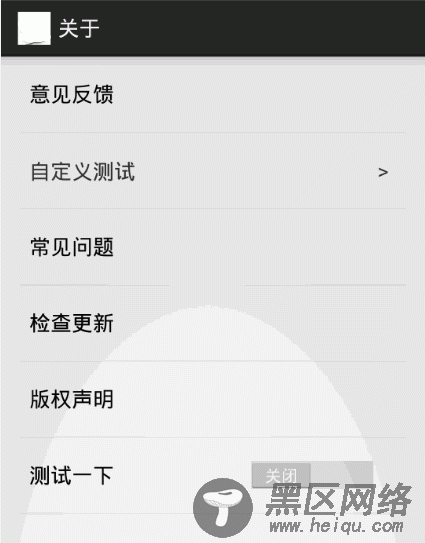Preference类直接继承于Object类。在上文的settings.xml中,定义好几个Preference,Preference只提供简单的文本显示,而它的的子类CheckBoxPreference,SwitchPreference,EditTextPreference等则提供了较为复杂的UI展示,并可以保存用户的设置数据,一般来说,这些子类Preference对于应用程序更加重要。关于如果使用这些子类对象,其实很简单,他们可以像UI控件在Layout中的用法类似的应用在Preference定义的xml文件(上文定义的settings.xml)中,基本上使用了eclipse代码提示功能就可以使用,这些用法基础但不是本文的说明重点。下面旨在介绍如何定义自己的Preference,先上图看效果。

图一 自定义Preference展示
图一展示了Preference与自定义Preference样式差别,你或许注意到第二项”自定义测试“与其他的Preference只有一个“>“符号的差别,其实这里包含了自定义一个Preference的完整步骤。说道这里,顺便说下,其实自定义Preference与自定义控件的方法和套路几乎一致。还是总结下基本步骤。
1) 定义属性值 attr.xml
<?xml version="1.0" encoding="utf-8"?>
<resources>
<declare-styleable>
<attr format="string"></attr>
<attr format="string"></attr>
</declare-styleable>
</resources>
2) 设计自定义Preference的布局 preferencewithtip.xml
<?xml version="1.0" encoding="utf-8"?>
<LinearLayout xmlns:android="http://schemas.android.com/apk/res/android"
android:layout_width="match_parent"
android:layout_height="match_parent"
android:orientation="horizontal"
android:paddingLeft="8dp"
android:paddingRight="15dp"
android:paddingTop="20dp"
android:paddingBottom="20dp">
<TextView
android:id="@+id/prefs_title"
android:layout_width="0dp"
android:layout_height="wrap_content"
android:layout_gravity="left"
android:gravity="left|center_vertical"
android:textSize="18sp"
android:layout_weight="1"/>
<TextView
android:id="@+id/prefs_tip"
android:layout_width="0dp"
android:layout_height="wrap_content"
android:layout_gravity="right"
android:gravity="right|center_vertical"
android:textSize="18sp"
android:layout_weight="1"/>
</LinearLayout>
3) 继承Preference,实现自己的Preference类 PreferenceWithTip
public class PreferenceWithTip extends Preference {
private static final String TAG = "PreferenceWithTip";
String pTitle = null;
String tipstring = null;
@SuppressLint("Recycle")
public PreferenceWithTip(Context context, AttributeSet attrs, int defStyle) {
super(context, attrs, defStyle);
// 获取自定义参数
Log.i(TAG,"PreferenceWithTip invoked");
TypedArray ta = context.obtainStyledAttributes(attrs, R.styleable.PreferenceWithTip);
tipstring = ta.getString(R.styleable.PreferenceWithTip_tipstring);
pTitle = ta.getString(R.styleable.PreferenceWithTip_titlestring);
ta.recycle();
}
public PreferenceWithTip(Context context, AttributeSet attrs) {
this(context, attrs, 0);
}
@Override
protected void onBindView(View view) {
super.onBindView(view);
TextView pTitleView = (TextView)view.findViewById(R.id.prefs_title);
pTitleView.setText(pTitle);
TextView pTipView = (TextView)view.findViewById(R.id.prefs_tip);
pTipView.setText(tipstring);
}

